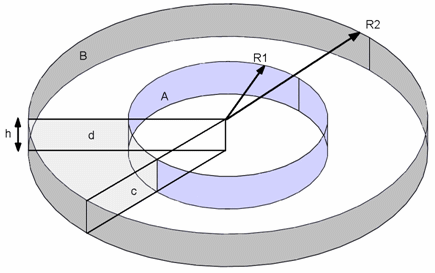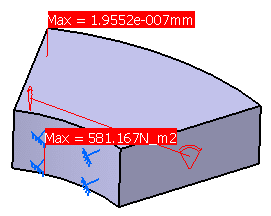This test lets you check the periodicity. The disc is pierced, the inner surface is fit and the outer surface is submitted to a plane torsion. Thus, the geometry and the limit conditions are periodic.
Reference:
3D model with linear hexahedron elements (HE8), computed with CATIA.
 Specifications
Specifications
Geometry Specifications
|
R1 = 0.05 m R2 = 0.1 m h = 0.02 m |
|
|
|
For symmetry reasons, only 1/8 of the body is modeled. The given results are the same for 1/8 or for the whole body. |
Analysis Specifications
|
Young Modulus (material): |
|
|
Poisson's Ratio (material): |
|
|
Mesh Specifications:
|
|
|
Restraints: |
|
|
Loads (Surface force density): |
 Results
Results
The table below presents the analysis results:
|
Type of values |
Full disc model (reference) |
1/8 disc model |
Normalized results (1/8 model / full model) |
|
Maximum displacement amplitude (mm) |
1.95247 x 10-7 |
1.9552 x 10-7 |
1.00140 |
|
Maximum |
586.275 |
581.167 |
0.99129 |
To Perform the Test:
The periodicity_full.CATAnalysis document presents a complete analysis, computed with a mesh formed of linear hexahedron elements (HE8).
The periodicity_partial.CATAnalysis document presents a partial analysis, computed with a mesh formed of linear hexahedron elements (HE8).
To compute the case, proceed as follow:
Open one of the CATAnalysis documents.
Compute the case in the Generative Structural Analysis workbench.
-
Create local sensors (Displacement magnitude and Von Mises stress).

